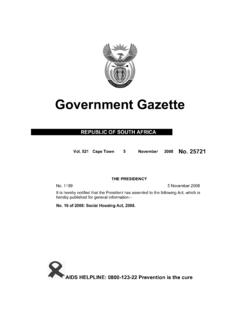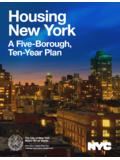Transcription of Tax Increment Financing (TIF) Funding and …
1 Tax Increment Financing (TIF) Funding and affordable HousingAn analysis of current TIF resources and City of Chicago TIF-funded housing 1995-2008 June, 2009 Sweet Home Chicago CoalitionAction NOWA lbany Park Neighborhood CouncilBickerdike Redevelopment CorporationChicago Coalition for the HomelessJane Addams Senior CaucusKenwood Oakland Community OrganizationLakeview Action CoalitionLogan Square Neighborhood AssociationOrganization of the NortheastSEIU-Healthcare Illinois/IndianaSEIU Local 1 United Food and Commercial Workers Local 881 Report Prepared by Chicago Coalition for the Homeless on behalf of the Sweet Home Chicago CoalitionReport Author: Julie Dworkin, Director of Policy, Chicago Coalition for the HomelessResearchers: Stephanie Procyk and Jim PicchettiExecutive SummaryA serious affordable housing crisis, which has plagued the City of Chicago for more than a decade, has deepened drastically during the last two years due to the rise in foreclosures and unemployment.
2 Meanwhile, through its 158 active Tax Increment Financing (TIF) districts, the city has accumulated, and likely will continue to generate, a large surplus of funds that could be used to alleviate the affordable housing districts were created to promote revitalization of blighted or struggling neighborhoods, and the availability of affordable housing is instrumental to a neighborhood s stability. Unfortunately, the city s policy on the use of TIF funds for housing has not gone far enough to adequately address the fundamental need for affordable housing in developing neighborhoods. Expenditures on affordable housing have accounted for too small of a percentage of TIF funds. An even smaller percentage of TIF funds have supported housing affordable to people in the neighborhoods in which it is built and for those with the greatest housing findings are:As of 2008, there was nearly $1 billion built up in Chicago s TIF accounts at least $350 million of which has not been dedicated to a particular Between 1995-2007, only 4 percent of TIF funds were targeted for develop- ment of affordable (Note: 1995 was the first year the Chicago Department of housing began issuing detailed reports on its production and spending)TIF funds have been used to create housing that is more expensive and tar- geted for higher incomes than existing housing in the neighborhoods in which it has been created.
3 In 50 percent of the wards in which TIF-funded housing was built, at least half of the units were too expensive for current TIF-funded units go disproportionately to higher income households. Between 1995-2008, only 27 percent of the units created with TIF funds went to the households with the most critical needs those earning less than $20,000 a Recommendations:Target 20 percent of TIF funds each year for affordable housing . For those targeted dollars, affordable should be defined as housing that meets the needs of neighborhood residents and those with the greatest need. 3 Chicago s housing Crisis Chicago is experiencing a housing crisis, but this is not a new problem. Certainly the foreclosure crisis is in the forefront of everyone s mind when they think about housing needs in Chicago. In 2008, 20,592 foreclosures were filed in Chicago, a 48 percent increase from 2007. Of those, 6,589 were two-six unit buildings--meaning up to 39,000 renters potentially faced eviction due to Foreclosures have exacerbated the housing crisis by increasing demand and decreasing the supply of affordable housing .
4 But even before this spike in foreclosures, Chicago s housing needs were great: In Chicago in 2007, 50% of renters and 43% of homeowners paid more than 30% of their income for This is considered unaffordable and puts people at risk of homelessness or 2007, 42,281 households were on the public housing waiting list in Chicago. 7In 2008, when CHA opened the waiting list for Section 8 vouchers more than 200,000 people vied for 40,000 slots on the waiting By 2011, approximately 17,000 units of federally subsidized housing in Chicago could be lost due to expiring The Chicago housing Authority s Plan for Transformation will result in a net loss of 13,000 public housing units in In the 2008-2009 school year, a record 12,525 students were identified as homeless in the Chicago Public Schools. This number represents an 18% increase over the number identified the previous school Tax Increment Financing : A city resource to address housing needsTax Increment Financing (TIF) is a tool the city uses to spur economic development in a specific geographic area that is considered blighted.
5 The area is designated a TIF district and then when development takes place and property taxes rise, any increase in property tax revenues go into a fund that must be spent on redevelopment projects in the TIF. State law dictates what TIF Funding can be spent on. Allowable uses include: public improvements such as streets, streetscaping and sewers; redevelopment costs such as acquiring and rehabbing properties or demolition of existing properties; Financing and administrative costs associated with development. Construction of affordable housing is specifically spelled out in state law as an allowable use. In fact, up to 50 percent of the cost of construction for a particular affordable housing project can be paid for out of TIF in ChicagoThe city of Chicago has used TIFs widely in its efforts to redevelop neighborhoods in Chicago. There are now 158 TIF districts in Chicago covering 30 percent of the land in the city. The TIFs in Chicago are collectively generating a large amount of money.
6 In 2007 they generated $555 Each year more money is generated than is spent on projects so the TIF accounts continue to grow over time. Amount of available TIF fundsAn analysis of the 2007 audits of all TIF accounts found that at the end of 2007 there was nearly $1 billion in the TIF accounts available for redevelopment projects including affordable housing . The audits showed that 57 TIFs (35 percent) had fund balances in excess of $5 million and 27 had fund balances in excess of $10 million (see appendices for specific TIF balances and location of larger balances).13 A more recent document released by the Chicago Department of Community Development says that unaudited 2008 balances still total $1 billion. The same document also says that the city plans to spend $478-$643 million of that balance in 2009,14 leaving at least $350 million in the accounts plus whatever is collected in 2009. There are clearly available funds that could be dedicated for affordable housing , and now seems to be a critical time to use them.
7 Needs are higher due to the recession, and other resources for affordable housing are declining. The Illinois affordable housing Trust Fund, the state s primary source of capital funds for housing development is funded through the state s Real Estate Transfer Tax. The transfer tax has seen a severe loss of revenue due to the collapse of the real estate market. At its peak in 2006, the Trust Fund saw $71 million in revenue. In 2009, it is expected to receive just $42 million, a 42% decrease. The low-income housing tax credit, the primary federal source of Funding for affordable housing is expected in 2009 to generate only 30% of the capital it has in recent of Chicago s use of TIF funds for affordable housingDespite a large and growing pot of money in TIF accounts and a growing need for affordable housing , the city has spent a very small percentage of TIF funds on developing affordable chart below shows the total amount of TIF Funding that has gone into affordable housing developments.
8 It should be noted that the affordable housing spending shown below includes money that went towards Chicago housing Authority public housing redevelopments. While those redevelopments include affordable units, many of the units are only replacing other units that have been demolished. The chart does not include TIF Funding that went to market rate developments that include some affordable units as it is meant to show the investment in projects that are specifically intended to be affordable housing . Investment in market rate developments will be discussed Revenue Totals by Year15 Total TIF Revenue spent on affordable housing Developments*16% of Total TIF Revenue1995$44 million$960,0002%1996$50 million$ million4%1997$61 million$ million8%1998$77 million$2. 7 million3%1999$93 million$ million11%2000$129 million$ million3%2001$159 million$ million2%2002 $217 million $ million 1%2003 $287 million $ million 4%2004 $329 million $ million 1%2005 $387 million $ million 11%2006 $500 million $29 million 6%2007 $555 million $ million 2%Total$ billion$ million4%*54 percent of the housing Funding shown in this column was for Chicago housing Authority Plan for Transformation replacement units6 housing created with TIF funds too expensive for Chicago residentsAccording to state statute, one of the primary uses of TIF Funding is to increase the property tax base in a given area.
9 This can have the effect of gentrifying a neigh-borhood and therefore making it unaffordable for the current residents. Because of this, the city created a policy to ensure some affordability of housing units created with TIF funds. However, an analysis of the data shows that the policy did not go far enough. The income levels for which the TIF-funded housing is targeted exceed the median income in the city and are far greater than the income levels of families most in need of affordable 40 percent of households in Chicago earn less than $35,000 a year and nearly one-third of Chicago households earn less than $25,000 a year,17 the city s policy for affordable housing created with TIF funds only requires units to be cre-ated for households (based on a family of four) earning $45,000 a year (60 percent of area median income (AMI)) for rental housing and $75,000 a year (100 percent of AMI) for for-sale Because the area median income used by the city to calculate affordability ($75,000) includes the suburbs in the region, it is much higher than the median income just in Chicago ($43,000).
10 Therefore, although all affordable units are in theory supposed to target households at or below the median income, the chart below indicates that 50 percent of the TIF units created were for households earning above the city of Chicago s LevelBased on family of fourUnits created1995-2008 Percent of TotalUp to $22,600 177327%$22,600-$37,700153624%$45,240 207732%$60,300-$75,400114818%Total653410 0%(Source: Department of housing Quarterly Progress Reports)Disparity between housing created and neighborhood incomes by wardA ward-by-ward analysis of TIF-funded housing developments reveals a more detailed view of how the units created price out housing In keeping with the city s policy, between 1995 and 2008, 39 percent of the rental housing units created with TIF Funding were for households earning 60 percent of the area median income in Chicago. At that income level, rents for a 2-bedroom must not be more than $1,019. However, that amount exceeds the average rent in many of the wards where this TIF-funded housing was created.




